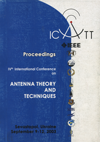The synthetic aperture method in the environment microwave interferometer radiometry
DOI:
https://doi.org/10.1109/ICATT.2003.1239166Keywords:
microwave emission, antenna configuration, synthetic aperture, spacecraft visibility function, angular resolution, radiometric sensitivityAbstract
The basic principles of space-borne two dimensional synthetic aperture microwave polarimetric interferometer function are considered. The main advantages of these systems over the well-known systems ESMR, SMMR and SSM/I are: a high rate of the observation scene image construction; the finite angular resolution; besides, they have no movable onboard construction elements on the spacecraft board, like the scanning antenna, and etc. The advantages of the synthetic aperture systems with hexagonally sampled interferometric radiometers are discussed.References
Zagorin, G.; et al. Proc. EUSAR’ 2000, 23-25 May, 2000, Munich, pp. 539-542, 2000.
Fomalont, E.B.; Wright, M.C.H. Interferometry and aperture synthesis, in Galactic and Extragalactic Radio Astronomy, pp. 256-290, eds. G. L. Verschuur and K. I. Kellerman. Springer-Verlag, New York, 1974.
Thompson, A.R.; et al. Interferometry and Synthesis Radio Astronomy. John Wiley & Sons, New York, 1986.
Welch, W.J.; et al. Astronomy & Astrophysics, 59, 379-385, 1977.
Kutuza, B.G.; Zagorin, G.K. Radio Science, 2003, Vol. 38, No. 3, p. 8055, doi: 10.1029/2002RS002651, MAR 20-1-MAR 20-7.
Bara, J.; et al. Radio. Sci., 33(5), 1459-1473, 1998.
Camps, A.; et al. IEEE Trans. on Geos. & Remote Sens., 36 (5), 1835, 1998.
Sodin, L.G.; Kopilovich, L.E. Izv. VUZov. Radiophyzika, Vol. XLII, No. 4, p. 345-349, 2000.
Mersereau, R.M. IEEE Trans., 1979, Vol. 67, No. 6, pp. 930-949.
Peichl, M. Radio Sci., 33(3), 781-801, 1998.
Le Vine, D. M. Radio Sci., 25(4), pp. 441-453, 1990.
Zagorin, G.K.; Kutuza, B.G. Voprosi perspektivnoi radiolokatsii. Radiotekhnika, 2003 [ed. A. V. Sokolov], pp. 464-486.

